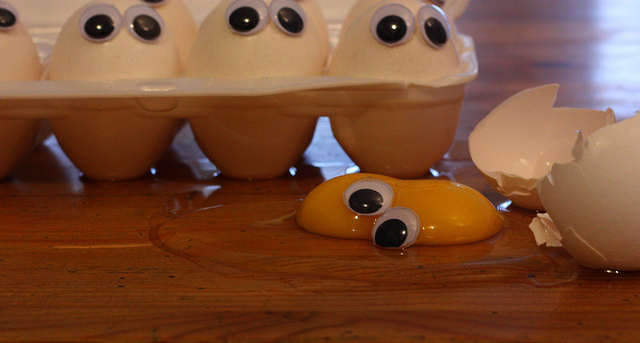Archive for the ‘Feelings’ Category
Connection Before Numbers
 Compound annual growth, profit margin, Key Business Indicators, capability indices, defects per million opportunity, confidence intervals, statistical significance, regression coefficients, temperature, pressure, force, stress, velocity, volume, inches, meters, decibels. The numbers are supposed to tell the story. But they don’t.
Compound annual growth, profit margin, Key Business Indicators, capability indices, defects per million opportunity, confidence intervals, statistical significance, regression coefficients, temperature, pressure, force, stress, velocity, volume, inches, meters, decibels. The numbers are supposed to tell the story. But they don’t.
There’s never enough data to see the whole picture. But, even when the discussion is limited to topics covered by the data, people don’t see things the same way. And even if the numbers were 100% complete, there would be no common interpretation. And if there was a common interpretation there’d be a range of diverging opinions on how to move forward. Even with perfect numbers, there is divergence among people.
Numbers are numb. They don’t have meaning until we attach it. And, as entities that attach meaning, we think do it rationally. But we use past history and fear to assign meaning. We are not rational, we’re emotional. Even the most rigorous scientist has an obsessive nature, infatuation and deep fascination. Even when swimming in a sea of data, we’re emotional, and, therefor, irrational.
Excitement, happiness, joy, anxiety, sadness, fear, collaboration, cooperation, competition, respect, disrespect, kindness, love. We live and work in a collection of people systems where emotion carries the day. Emotion and irrationality are not bad, it’s the way it is. We’re human. And, I’m thankful for it.
But with emotion and irrationality comes connection as part of the matched set. If you want one, you have to buy all three. And I want connection. Connection brings out the best in people – their passion, energy and love. When magical things happen at work, connection is responsible. And when magic happens at home, it’s connection.
I’m thankful I have strong connections.
Image credit – Irudayam
Dangerous Expectations
 Expectations result from mental models and wants. When you have a mental model of a system and you want the system to behave in a way that fits your mental model, that’s an expectation. And when you want the system to behave differently than your mental model, that’s also an expectation. When the system matches your wants, the world is good. And when your wants are out of line with the system, the world is not so good.
Expectations result from mental models and wants. When you have a mental model of a system and you want the system to behave in a way that fits your mental model, that’s an expectation. And when you want the system to behave differently than your mental model, that’s also an expectation. When the system matches your wants, the world is good. And when your wants are out of line with the system, the world is not so good.
Speculation is not expectation. Speculation happens when you propose, based on your mental model, how the system will behave. With speculation, there’s no attachment to the result, no wanting it to be one way or another. There’s just watching and learning. If the system confirms your mental model, the applicability of the model is reinforced (within this narrow context.) And when the system tramples your mental model, you change your mental model. No attachment, no stress, no whining, no self-judgement.
When doing work that’s new, system response is unknown. Whether the system will be exercised in a new way or it’s an altogether new system, metal models are young and untested. When it’s the first time, speculation is the way to go. Come up with your best mental model, run the experiment and record the results. After sitting in data, refine your mental model and repeat. If your mental model doesn’t fit the system, don’t judge yourself negatively, don’t hold yourself back, don’t shy away. Refine your mental model and build-test-learn as fast as you can. And if your mental model fits the system, don’t judge yourself in a positive way. This was your first test and you don’t understand the system fully. Refine your model and test for a deeper understanding. [Note – systems have been known to temporarily conform to mental models to obfuscate their true character.]
When doing work that’s new, expectation gets in the way. If you expect your models to be right and they’re not, you learning rate is slower than your expectations. That’s not such a big deal on its own, but the rippling self-judgement can be crippling. Your emotional state becomes fragile and it’s difficult to keep pushing through the work. You doubt yourself and your abilities; you won’t put yourself out there; and you won’t propose radical mental models for fear of looking like you don’t know what you’re doing. You won’t run the right experiments and you never the understand the fundamental character of the system. You block your own learning. If you expect your models won’t to fit the system, you block your learning from the start. Sometimes your lack of confidence blocks you from even trying. [Note – not trying is the only way to guarantee you won’t learn.]
Within the domain of experiments, mental models and generic systems, it’s relatively easy to see the wisdom of speculations and the perils of expectations, where wanting leads to judging and judging leads to self-blocking. But it’s not so easy to see in the domain of life where experiments are replaced with personal interactions and generic systems are replaced with everyday situations and mental models are ever-present. But in both domains the rules and consequences are the same.
Just as in the lab, in day-to-day life expectations are dangerous.
Image credit – Dermot O’Halloran
If you believe…
If you believe the work is meaningful, best effort flows from every pore.
If you believe in yourself, positivity carries the day.
If you believe the work will take twelve weeks, you won’t get it done in a day-and-a-half.
If you believe in yourself, when big problems find you, you run them to ground.
If you believe people have good intensions, there are no arguments, there is only progress.
If you believe in yourself, you are immune to criticism and negative self-talk.
If you believe people care about you, you’re never lonesome.
If you believe in your team, there’s always a way.
If you believe in yourself, people believe in you. And like compound interest, the cycle builds on itself.
Image credit – Joe Shlabotnik
People Are The Best Investment
 Anything that happens happens because of people, and anything that doesn’t happen doesn’t happen because of people. Technology doesn’t create itself, products don’t launch themselves, companies don’t build themselves and trust doesn’t grow on its own. Any kind of work, any kind of service, any kind of organizing – it’s all done by people.
Anything that happens happens because of people, and anything that doesn’t happen doesn’t happen because of people. Technology doesn’t create itself, products don’t launch themselves, companies don’t build themselves and trust doesn’t grow on its own. Any kind of work, any kind of service, any kind of organizing – it’s all done by people.
The productivity/quality movement has been good for factories – parts move in a repeatable flow and they’re processed in repeatable ways by machines that chunk out repeatable output. Design the process, control the inputs and turn the crank. Invest in the best machines and to do the preventative maintenance to keep them in tip-top shape. Just follow the preventive maintenance (PM) schedule and you’ll be fine. But when the productivity/quality movement over-extended into the people domain, things don’t go as well.
People aren’t machines, and their work product is not cookie-cutter parts. And, there’s no standard PM schedule for people. We all know this, but we behave like people are machines – we design their work process, train them on it and measure their output. But machines are iron-based entities that don’t have consciousness and people are carbon-based beings with full consciousness. The best machines do what their told, but the best people tell you what to do. Machines and people are fundamentally different, but how we run them is markedly similar.
Where machines need oil, people need empathy. And for empathy you need vulnerability and for that you need trust. But there’s no standard PM schedule for trust. There’s no flowchart or troubleshooting protocol for helping people. What work do you give them? It depends. When do you touch base and when do you leave them alone? It depends. How much responsibility do you give them? It depends. With machines it’s follow the PM schedule and with people – it depends.
Where machines wear out, people develop and grow. And to grow people you need to see them as they are and meet them where they are. And to do that you’ve got to see yourself as you are. You can’t give people what they need if you add to the drama with your reactivity and you can’t discern their suffering from your projections if you’re not grounded. How much time do you spend each day to learn to dampen your reactivity? How much time do you spend to slow your monkey mind so you can see your projections?
With machines it’s control the inputs and get what you got last time. With people it’s maybe; it depends; don’t worry about how it will go; and why don’t you try? Growing people is much more difficult than keeping machines running smoothly. But, there is nothing more fulfilling than helping people grow into something they couldn’t imagine.
Image credit – Benjamin Balazs
Hep
When doing new work, you’ll be wrong.
 When doing something from the first time you’re going to get it wrong. There’s no shame in that because that’s how it goes with new work. But more strongly, if you don’t get it wrong you’re not trying hard enough. And more strongly, embrace the inherent wrongness as a guiding principle.
When doing something from the first time you’re going to get it wrong. There’s no shame in that because that’s how it goes with new work. But more strongly, if you don’t get it wrong you’re not trying hard enough. And more strongly, embrace the inherent wrongness as a guiding principle.
Take Small Bites. With new work, a small scope is better than a large one. But it’s exciting to do new work and there’s a desire to deliver as much novel usefulness as possible. And, without realizing it, the excitement can lead to a project bloated with novelty. With the best intentions, the project team is underwater with too much work and too little time. With new work, it’s better to take one bite and swallow than three and choke.
Ratchet Thinking. With new work comes passion and energy. And though the twins can be helpful and fun to have around, they’re not always well-behaved. Passion can push a project forward but can also push it off a cliff. Energy creates pace and can quickly accelerate a project though the milestones, but energy can be careless and can just as easily accelerate a project in the wrong direction. And that’s where ratchet thinking can help.
As an approach, the objective of ratchet thinking is to create small movements in the right direction without the possibility of back-sliding. Solve a problem and click forward one notch; solve a second problem and click forward another notch. But, with ratchet thinking, if the third problem isn’t solved, the project holds its ground at the second notch. It takes a bit more time to choose the right problem and to solve it in a way that cannot unwind progress, but ultimately it’s faster. Ratchet thinking takes the right small bite, chews, swallows.
Zero Cost of Change. New work is all about adding new functions, enhancing features and fixing what’s broken. In other words, new work is all about change. And the faster change can happen, the faster the product/service/business model is ready for sale. But as the cost of change increases the rate of changes slows. So why not design the project to eliminate the cost of change?
To do that, design the hardware with a bit more capability and headroom so there’s some wiggle room to handle the changes that will come. Use a modular approach for the software to minimize the interactions of software changes and make sure the software can be updated remotely without customer involvement. And put in place a good revision control (and tracking) mechanism.
Doing new work is full of contradictions: move quickly, but take the time to think things through; take on as much as you can, but no more; be wrong, but in the right way; and sometimes slower is faster.
But doing new work you must.
image credit – leasqueaky
Progress is powered by people.
People ask why.
People buy products from people.
The right people turn activity into progress.
People want to make a difference, and they do.
People have biases which bring a richer understanding.
People use judgement – that’s why robots don’t run projects.
People recognize when the rules don’t apply and act accordingly.
Business models are an interconnected collection of people processes.
The simplest processes require judgement, that’s why they’re run by people.
People don’t like good service, they like effective interaction with other people.
People are the power behind the tools. (I never met a hammer that swung itself.)
Progress is powered by people.
Image credit – las – intially
Put your success behind you.
The biggest blocker of company growth is your successful business model. And the more significant it’s historical success, the more it blocks.
Novelty meaningful to the customer is the life force of company growth. The easiest novelty to understand is novelty of product function. In a no-to-yes way, the old product couldn’t do it, but the new one can. And the amount of seconds it takes for the customer to notice (and in the case of meaningful novelty, appreciate) the novelty is in an indication of its significance. If it takes three months of using the product, rigorous data collection and a t-test, that’s not good. If the customer turns on the product and the novelty smashes him in the forehead like a sledgehammer, well, that’s better.
It’s difficult to create a product with meaningful novelty. Engineers know what they know, marketers know what they market, and the salesforce knows how to sell what they sell. And novelty cuts across their comfort. The technology is slightly different, the marketing message diverges a bit, and the sales argument must be modified. The novelty is driven by the product and the people respond accordingly. And, the new product builds on the old one so there’s familiarity.
Where injecting novelty into the product is a challenge, rubbing novelty on the business model provokes a level 5 pucker. Nothing has the stopping power of a proposed change to the business model. Novelty in the product is to novelty in the business model as lightning is to lightning bug – they share a word, but that’s it.
Novelty in the product is novelty of sheet metal, printed circuit boards and software. Novelty in the business model is novelty in how people do their work and novelty in personal relationships. Novelty in the product banal, novelty in the business model is personal.
No tools or best practices can loosen the pucker generated by novelty in the business model. The tired business model has been the backplane of success for longer than anyone can remember. The long-in-the-tooth model has worn deep ruts of success into the organization. Even the all-powerful Lean Startup methodology can’t save you.
The healing must start with an open discussion about the impermanence of all things, including the business model. The most enduring radioactive element has a half-life, and so does the venerable business model, even the most successful.
Where novelty in the product is technical, novelty in the business model is emotional. And that’s what makes it so powerful. Sprinkling the business model with novelty is scary at a deeply personal level – career jeopardy, mortgage insecurity and family volatility are primal drivers. But if you can push through, the rewards are magical.
Your business model has shaped you into an organization that’s optimized to do what it does. You can’t create new markets and sell to new products to new customers without changing your business model. Your business model may have been your secret sauce, but the world’s tastes have changed. It’s time to put your success behind you.
Image credit — MandaRose
The cards don’t matter. What matters is how you play them.
 What you think of yourself colors everything you do. When someone challenges your ideas, your response makes it clear how you see yourself. Regardless of your response, you tip your hand. Regardless of your response, everyone can see your cards.
What you think of yourself colors everything you do. When someone challenges your ideas, your response makes it clear how you see yourself. Regardless of your response, you tip your hand. Regardless of your response, everyone can see your cards.
When you have a terrible poker hand like, say, a king high, you can respond three ways. You can fold and let the challenger go unchallenged. You can check and kick the can down the road. Or you can bluff and go toe-to-toe with the challenger. With the fold you see things as they are and behave accordingly. The fold is an admission you have a lesser hand. And sometimes that’s difficult to do. The check says you don’t want others to know you have a terrible hand but you thing things will turn around. With the bluff you pretend things are different than they are and you pretend accordingly. You may fool the unseasoned player on your right, but make no mistake, the card shark on your left knows you’re bluffing. And deep down, you know too.
With a middle-of-the-road hand like the full house you have the same options. The fold is less likely because your hand is stronger. You fold only when you sense a strong challenge and the pot is large. No sense going head-to-head with a player with swagger when the stakes are high. There’s no harm in folding. The check says you’re not sure of yourself, or, you are and your hand is neither special nor terrible. The bluff is still risky but less so. If you think you can survive getting caught and are okay with the follow-on judgement, there’s a larger probability you’ll try.
With four aces you call the shots. The fold is reserved for those special situations where you want to preserve the status of players you care about. Or, when you have enough chips and you want others to get the glory. Either way it’s too little used. Few have the self-worth, generosity and thoughtfulness to play things that way. The check is equally generous. The check says you’re comfortable with your cards and how the hand is going. No need to flex your muscles. When you have the winning cards the bluff is counterproductive. Playing bigger than your hand pushes everyone away and they fold. You may with the pot, but next hand they’ll go after you. Embarrassing the other players is no way to play.
Really, though, your cards don’t matter. Regardless of your cards, don’t take a challenge personally. Regardless of your cards, respond like you hold all of them – all the aces, face cards, and all the wild cards.
It relatively easy to behave this way when the professional challenges your ideas because they don’t challenge you, they challenge your ideas. And you are not your ideas. Look deeply and honestly at the ideas and leave your self out of it. But it’s more difficult with the hack. Under the banner of challenging your ideas, the hack will try to challenge you. Here’s where you’ve got to hold onto a fundamental truth – no one can challenge you without your consent. Here’s where you’ve got to remember this truth applies to everyone – those with a four-of-a-kind, those with a full house, and those with a pair of twos. Here’s where you’ve got to remember that your cards don’t matter. The best way I know how to do that is to visualize your self as a screen door and let their hot air pass through you.
The challenges don’t matter and neither does the hand you were dealt. All that matters is your response. Respond with your heart’s best intentions and everyone will split the pot and they’ll want you to deal every hand.
Image credit – lawrence
Skillful and Unskillful
 I used to believe others were responsible for my problem, now I believe I am responsible. The turning point came when I was struggling with a stressful situation a friend gave me some simple advice. He said “Look inside.” For some reason, that was enough for me to start my transformation.
I used to believe others were responsible for my problem, now I believe I am responsible. The turning point came when I was struggling with a stressful situation a friend gave me some simple advice. He said “Look inside.” For some reason, that was enough for me to start my transformation.
I used to compare myself to others. It caused me great pain because I judged myself as inferior. Over time I learned that others compared themselves to me and felt the same way. Also, I learned that success brings problems of its own, namely worry and anxiety around losing what “success” has brought. Though I still sometimes feel inferior, I’ve learned to recognize the symptoms, and once I call them by name, I can move forward.
I used to care too much about money. Though I still care about money, I care more about time.
I used to wrestle with the past and worry about the future. Now I sit in the present, and I like it better. I still slip sometimes, but I catch myself pretty quickly.
I used to be largely unaware of my lack of awareness. Now that I’ve learned to be more aware of it, I’m closer to the people I care about. And I’m aware that I’m just getting started.
I used to want more of everything. Now I have enough and I want to enjoy it.
I used to want to climb the corporate ladder, now I want to do amazing work.
I used to judge my younger self though my older self’s eyes. That was unskillful. I’ve realized that as a younger person my intensions were good, just as they are today. And, I’ve learned that perfection is an unattainable goal and that sometimes I forget.
I used to think that I had to do everything myself. Now I get great joy from helping others do things they thought they couldn’t.
I used to think of myself as a steamroller and I was proud of it. Now I’m a behind-the-scenes conductor who is far more effective and much happier.
I used to be afraid to share my inner thoughts and feelings, but I’m getting better at that.
Image credit – Jai Kapoor
The Fear of Being Judged
 “Here – I made this.” Those are courageous words. When you make something no one has made and you show people you are saying to yourself – “I know my work will be judged, but that’s the price of putting myself out there. I will show my work anyway.” I think the fear of being judged is enemy number one of creativity, innovation, and living life on your own terms. If I had ten dollars of courage in my pocket I’d spend it to dampen my fear of being judged.
“Here – I made this.” Those are courageous words. When you make something no one has made and you show people you are saying to yourself – “I know my work will be judged, but that’s the price of putting myself out there. I will show my work anyway.” I think the fear of being judged is enemy number one of creativity, innovation, and living life on your own terms. If I had ten dollars of courage in my pocket I’d spend it to dampen my fear of being judged.
No one has ever died from the fear of being judged, but right before you show your new work, share your inner feelings or show your true self, is sure feels like you’re going to be the exception. The fear of being judged is powerful enough to generate self-limiting behavior and sometimes can completely debilitate. It’s vector of unpleasantness is huge.
At a lower level, the fear of being judged is the fear someone will think of you differently than you want them to. It’s a fear they’ll label you with a scarlet letter you don’t want to own. This mismatch is the gradient that drives the fear. If you reduce the gradient you reduce the fear and the self-censorship.
No one can label you without your consent, and if you don’t consent there is no gradient. If you think the scarlet letter does not fit you, it doesn’t. No mismatch. When someone tries to hand you a gift and instead of taking it from them you let it drop to the floor, it’s not your gift. If you don’t accept their gift there is no gradient. But there is a gradient because you think the scarlet letter may actually fit and the gift may actually be yours. You create your fear because you think they may be right.
In the end it’s all about what you think about yourself. If your behavior is skillful and you know it, you will not accept someone else’s judgment and there’s no fear-fueling gradient . If your approach is purposefully thoughtful, you will not consent to labeling. If you know your intentions are true, there can be no external mismatch because there is no internal mismatch.
No one can be 100% skillful, purposeful, thoughtful and intentional. But directionally, behaving this way will reduce the gradient and the fear. But the fear will never go away, and that’s why we need courage. Be skillful and afraid and do it anyway. Be thoughtful and scared and do what scares you. Be true to your heart’s intention and just courageous as you need to be to wrestle your fears to the ground.
Image credit – Paul Townsend
A Life Boat in the Sea of Uncertainty
 Work is never perfect, family life is never perfect and neither is the interaction between them. Regardless of your expectations or control strategies, things go as they go. That’s just what they do.
Work is never perfect, family life is never perfect and neither is the interaction between them. Regardless of your expectations or control strategies, things go as they go. That’s just what they do.
We have far less control than we think. In the pure domain of physics the equations govern predictively – perturb the system with a known input in a controlled way and the output is predictable. When the process is followed, the experimental results repeat, and that’s the acid test. From a control standpoint this is as good as it gets. But even this level of control is more limited than it appears.
Physical laws have bounded applicability – change the inputs a little and the equation may not apply in the same way, if at all. Same goes for the environment. What at the surface looks controllable and predictable, may not be. When the inputs change, all bets are off – the experimental results from one test condition may not be predictive in another, even for the simplest systems, In the cold, unemotional world of physical principles, prediction requires judgement, even in lab conditions.
The domains of business and life are nothing like controlled lab conditions. And they’re and not governed by physical laws. These domains are a collection of complex people systems which are governed by emotional laws. Where physics systems delivers predictable outputs for known inputs, people systems do not. Scenario 1. Your group’s best performer is overworked, tired, and hasn’t exercised in four weeks. With no warning you ask them to take on an urgent and important task for the CEO. Scenario 2. Your group’s best performer has a reasonable workload (and even a little discretionary time), is well rested and maintains a regular exercise schedule, and you ask for the same deliverable in the same way. The inputs are the same (the urgent request for the CEO), the outputs are far different.
At the level of the individual – the building block level – people systems are complex and adaptive, The first time you ask a person to do a task, their response is unpredictable. The next day, when you ask them to do a different task, they adapt their response based on yesterday’s request-response interaction, which results in a thicker layer of unpredictability. Like pushing on a bag of water, their response is squishy and it’s difficult to capture the nuance of the interaction. And it’s worse because it takes a while for them to dampen the reactionary waves within them.
One person interacts with another and groups react to other groups. Push on them and there’s really no telling how things will go. One cylo competes with another for shared resources and complexity is further confounded. The culture of a customer smashes against your standard operating procedures and the seismic pressure changes the already unpredictable transfer functions of both companies. And what about the customer that’s also your competitor? And what about the big customer you both share? Can you really predict how things will go? Do you really have control?
What does all this complexity, ambiguity, unpredictability and general lack of control mean when you’re trying to build a culture of accountability? If people are accountable for executing well, that’s fine. But if they’re held accountable for the results of those actions, they will fail and your culture of accountability will turn into a culture of avoiding responsibility and finding another place to work.
People know uncertainty is always part of the equation, and they know it results in unpredictability. And when you demand predictability in a system that’s uncertain by it’s nature, as a leader you lose credibility and trust.
As we swim together in the storm of complexity, trust is the life boat. Trust brings people together and makes it easier to row in the same direction. And after a hard day of mistakenly rowing in the wrong direction, trust helps everyone get back in the boat the next day and pull hard in the new direction you point them.
Image credit – NASA



 Mike Shipulski
Mike Shipulski